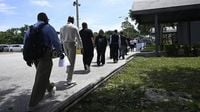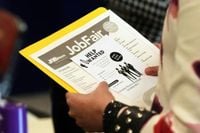The U.S. labor market, once a source of resilience for the world’s largest economy, has entered a period of undeniable fragility as of October 2025. With official government data delayed by a federal shutdown, investors, policymakers, and ordinary Americans are left to piece together a complex puzzle from private reports, analyst estimates, and anecdotal evidence. The resulting picture is one of rising unemployment, unexpected job losses, and a Federal Reserve forced to act decisively—even as uncertainty clouds every forecast.
On October 1, 2025, the ADP National Employment Report stunned markets by revealing a loss of 32,000 private sector jobs in September—a jarring reversal from expectations of modest growth and the largest such drop since March 2023. As reported by Market Minute, this figure followed a downward revision of August’s payrolls to a net loss of 3,000 positions, further underscoring the labor market’s rapid deceleration. The official unemployment rate, last recorded at 4.3% in August, has been steadily climbing since 2023 and now sits at its highest level in over a year.
Normally, the Bureau of Labor Statistics would have released its September jobs report on October 3, 2025. But as CNN explained, the ongoing government shutdown that began October 1 has shuttered the release of crucial economic data. Without these official figures, market participants have turned to private estimates and previously released numbers to gauge the state of the labor market. FactSet analysts, for example, had anticipated about 50,000 new jobs in September—a notable improvement over August’s meager 22,000. Private forecasts suggested the private sector would add roughly 62,000 jobs, partially offset by a loss of about 12,000 federal jobs.
Yet these glimmers of hope are clouded by the reality of weak hiring trends. Over the last three months, the average monthly job gain has been just 29,333, a stark contrast to the 240,000 jobs added in September 2024. As one analyst told CNN, "We have seen a story last year when hiring was very weak during the summer, and then hiring somewhat rebounded in September. I expect a similar development, but not as strong a rebound as last year." The structure of the labor market has shifted, with an aging population, reduced job-seeker activity, and migration factors all playing a role. Economists now estimate that only about 50,000 new jobs per month are needed to keep unemployment stable—down from roughly 130,000 last year.
Wage growth, another key indicator, has also started to cool. According to Market Minute, wage growth for job-changers fell to 6.6% in September from 7.1% in August, while pay for job-stayers remained relatively flat. FactSet data cited by CNN anticipated wage growth of about 0.3% month over month and 3.7% year over year in September, with the average workweek holding steady at 34.2 hours.
Sector-specific data paints a mixed picture. The construction industry, often seen as a bellwether for economic activity, has been hit hard. The JOLTS report for August showed a dramatic decline of about 115,000 vacancies in construction—the second-largest drop on record. High interest rates, housing affordability challenges, and migration dynamics are all weighing on the sector. As one economist told CNN, "This could also reflect internal problems in this sector." Meanwhile, the share of foreign-born workers has dipped after peaking earlier in the year, a trend attributed to both survey nonresponse and changing migration patterns.
Despite the broader slowdown, some bright spots remain. ADP’s report highlighted that health care and education added jobs in September, even as most other sectors contracted. As ADP noted, "Health care was one of the pillars of the labor market… demand for health care is rising due to an aging population." This has prompted some workers to consider career shifts into more stable fields. One job seeker told CNN, "I’m sending letters to schools now to return to training and move into health care – just to find some stability."
The Federal Reserve, for its part, has responded with a decisive shift in monetary policy. On September 17, 2025, the Fed cut interest rates by a quarter-point—the first reduction in nine months—citing labor market weakness as a principal justification. According to Market Minute, this move was seen as a proactive "risk management" measure to prevent a deeper downturn. Additional cuts are widely expected: another 25-basis-point reduction is anticipated in October, with a further cut possible in December, potentially bringing the federal funds rate to 3.5%-3.75% by year-end.
This dovish pivot has sparked a classic "bad news is good news" rally in financial markets. U.S. equities have surged to new highs and bond yields have tumbled as investors bet on continued monetary easing. Sectors sensitive to interest rates—such as real estate and homebuilders (Builders FirstSource, Mohawk Industries), industrials (Caterpillar, Jacobs Solutions), and technology (Nvidia, Alphabet)—are expected to benefit from cheaper borrowing costs and renewed investment. Defensive sectors like healthcare (IQVIA Holdings, Universal Health Services) and consumer staples (PepsiCo) are also seen as relatively resilient.
However, not all companies will benefit. Traditional financial institutions could face pressure on their net interest margins if lending rates fall faster than deposit rates, compressing profitability. Sectors reliant on robust consumer demand, such as leisure, hospitality, and parts of manufacturing and construction, may struggle if job insecurity dampens spending. Businesses slow to adopt AI and automation could also miss out on cost-saving opportunities, especially as labor-intensive tasks become more expensive.
For policymakers, the current environment presents a delicate balancing act. The Fed’s dual mandate of maximum employment and stable prices is under strain, with core PCE inflation projected at 2.6% for 2025—still above the central bank’s 2% target. The government shutdown exacerbates the challenge by forcing reliance on incomplete private data, raising the risk of policy missteps and market volatility. As Market Minute observed, this "flying blind" scenario makes the Fed’s careful communication and data-dependent approach more important than ever.
Looking ahead, the road forks in several directions. In the short term, the labor market is likely to continue its modest contraction, with further job losses possible as tariffs, weaker immigration, and elevated (if falling) interest rates constrain demand. The Fed is expected to maintain its easing cycle in an effort to stave off a sharper rise in unemployment. For businesses, this means prioritizing cost control, investing in productivity-boosting innovation, and managing debt prudently. Investors, meanwhile, may find opportunities in quality bonds and growth-oriented equities, particularly those tied to the AI boom, but should remain vigilant amid ongoing volatility.
Longer-term outcomes hinge on the Fed’s ability to engineer a "soft landing." If rate cuts successfully stimulate activity without reigniting inflation, the U.S. could see a period of slower but more stable growth, with the labor market gradually stabilizing. A downside scenario would involve a more painful recession, marked by significant job losses and a sharp equity market downturn. An upside, albeit less likely, could see resilient growth and mild inflation if the Fed’s cuts prove highly effective, prompting renewed business investment and a housing market rebound.
For now, the U.S. economy stands at a crossroads. The Federal Reserve’s commitment to supporting employment, even as inflation lingers above target, has injected optimism into markets—but the underlying economic fragility and persistent data gaps demand caution. As the shutdown drags on and official numbers remain out of reach, all eyes are on alternative indicators and the Fed’s next move. In this uneasy equilibrium, vigilance and adaptability are the watchwords for businesses, investors, and policymakers alike.





